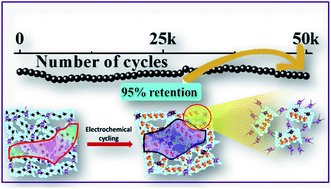Electrochemically customized assembly of a hybrid xerogel material via combined covalent and non-covalent conjugation chemistry: an approach for boosting the cycling performance of pseudocapacitors†
Abstract
Organic quinones conjugated with a conductive support like graphene via a covalent and/or non-covalent approach are emerging as low-cost and sustainable alternatives to conventional pseudocapacitive materials because of their fast and reversible redox kinetics. Herein, for the first time, reduced graphene oxide (rGO) networks functionalized with the eco-friendly dopamine (DA) moiety in a combined covalent and non-covalent manner have been explored by a facile hydrothermal synthesis method as high-performance pseudocapacitive materials. Further, a unique in situ electrochemical polymerization approach has been undertaken in an attempt to boost the overall storage capacity as well as cycling stability. Electrochemical tuning of the active material can result in an enhancement in the specific capacitance via dual improvement in faradaic and capacitive current as compared to the initial xerogel material, highlighting the significance of the in situ process. The electrode material shows a highest specific capacitance (CSP) of 348 F g−1 at a current density of 0.5 A g−1 in 1 M H2SO4 while retaining 60% of its initial capacitance even at a very high current density of 200 A g−1. A metal-free all-solid-state symmetric supercapacitor was developed with the in situ electropolymerized active material and the as-fabricated device exhibits an excellent CSP of 218 F g−1 at 0.325 A g−1 in 1 M PVA/H2SO4 gel electrolyte with a maximum energy density of 30.3 W h kg−1 and power density up to 13 kW kg−1. Most importantly, the material exhibited an extraordinary stability of 53 000 charge–discharge cycles while retaining 94% of its initial capacitance, while the device also shows an excellent capacitance retention of 92% even after 10 000 continuous cycles. Simultaneously, the DFT study was amended to understand the covalent and non-covalent interaction of the redox species, its charge storage mechanism and charge density distribution as well as to calculate the density of states.

- This article is part of the themed collection: 2022 Journal of Materials Chemistry Lectureship shortlisted candidates


 Please wait while we load your content...
Please wait while we load your content...